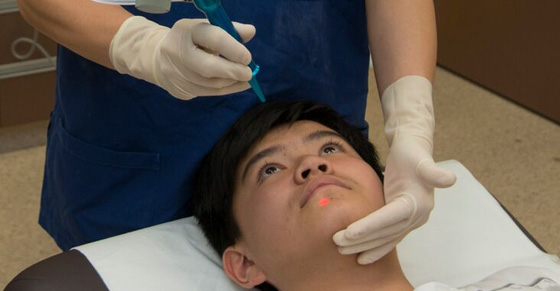Common causes of scars include trauma, surgery and acne. Treatment is usually sought for scars that are unsightly, symptomatic (itching, pain) or causing distortion of the surrounding structures. Some individuals are more prone to lumpy keloid scars which commonly occur on the chest, shoulders, back, ears and in some women having had Caesarean section. Atrophic (depressed) scars are common following acne or trauma.
Scar revision and treatment involve many techniques such as subcision, surgical revision, lasers (vascular, fractional and ablative) and corticosteroid injections. The choice of the most appropriate treatment technique depends on the type and position of the scar. Importantly, early treatment generally results in significantly better outcomes, particularly for traumatic or surgical scars. Dermatologists at our clinic have an interest in scar treatment and can consult you on the most appropriate treatment modalities for your scar(s).

Thickened scars (hypertrophic and keloid)
Thickening in a scar is usually due to hypertrophic and/or keloidal scarring. Hypertrophic scars usually develop within weeks of an injury or surgery while keloid scars may appear many years after the causative trauma or seemingly appear spontaneously. Thickened scars can occur after even minor trauma or mild acne particularly in predisposed individuals. Risk factors for thickened scars include:
- African or Asian ethnicity
- Adolescence and young adulthood at the time of scarring
- Scars due to burns or infections
- Scars located on earlobes, jaw, neck, upper back, chest or shoulders
- Scars subjected to tension such as over the joints
Hypertrophic scars appear red and raise but tend to improve over time. However, keloid scars are usually sensitive (painful or itchy) and can continue to grow over months or years, occasionally to a very large size. Treatments that can be used include:
- Silicone gel or sheets
- Mechanical compression such as pressure earrings or body garments
- Intralesional injections with corticosteroids, 5-fluorouracil, verapamil, bleomycin or botulinum toxin
- Cryotherapy
- Radiotherapy
- Lasers such as pulsed dye lasers or fractional ablative laser
- Surgical revision: additional post-operative treatment is usually required to prevent recurrence
Acne scars
Acne may cause a number of types of scars. Treatment must be individualized depending on the scar type and location, severity as well as your own circumstances
- Keloid and hypertrophic scars: treatment as discussed in the above section
- Box-car scars due to localized loss of the skin dermis. Treatment aims to replace and/or stimulate of regeneration of the lost dermis
- Chemical peels
- Dermabrasion
- Microneedling
- Fractional ablative laser
- Radiofrequency devices
- Dermal fillers
- Dermal grafts
- Ice-pick scars due to loss of skin dermis with fibrous tracts running deep into the skin. These are difficult to treat and usually require surgical excision
- Rolling scars due to skin being tethered down. Treatment for these scars usually requires subcision to release the fibrous tethering strands. due to large deep scars that usually arise after deeper acne nodules heal
